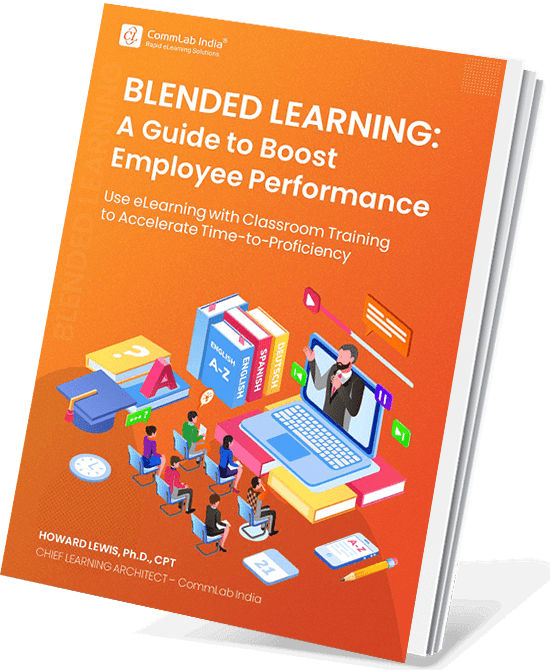Top 5 Blended Learning Techniques for a Smooth Employee Onboarding

Both employees and businesses are becoming more proactive in the current business environment whenever it pertains to their preferred working arrangements. This effectively implies that fresh personnel, whether seasoned or not, will continually be entering the organization. For each of these individuals to properly integrate into the fabric of your business, they will require some sort of onboarding, and blended learning can help!
→ Download Now: Blended Learning — A Guide to Boost Employee Performance [eBook]
A successful onboarding program makes sure that your recruits receive the necessary assistance as they integrate into your company and that they’ll continue to be an asset in the long run. It involves more than just selecting exceptional people; you also need to support them. Generally speaking, a blended learning strategy may help your onboarding program by providing a variety of flexible training alternatives.
Therefore, the crucial question is: how can you lower the turnover rates of recruits? But first, let’s grasp why blended learning is essential for a successful onboarding process.
Wondering How to Create an Effective Blended Learning Program for Effective Onboarding?
Here Are the Top 5 Ways for Smooth Onboarding:
- Online Gateway for the First Meet-And-Greet Meetings
- Video-Based eLearning Courses for Brand Promotion
- Blended Method for Official Training Sessions
- Online Training with Scenarios to Clarify Roles
- Microlearning Titbits for Essential Assistance
Effective Onboarding Using Blended Learning
It is crucial to inform your workforce of their obligations inside the company to prevent misunderstandings. You may offer your new hires the finest of two separate training approaches during onboarding by using a blended learning strategy.
You may accentuate the significance of their duties and functions by including an instructor-led workshop. You may look at the real tasks they would carry out daily using an online training program. Now that we focused on the “Why?” of blended learning for onboarding training, let’s now address the trickier question: “How” do you use blended learning for successful onboarding?
5 Ways to Leverage Blended Learning for Onboarding
1. Online Gateway for the First Meet-And-Greet Meetings
An efficient orientation procedure begins well before your workforce arrives at the office. Why settle for the traditional first-day meet-and-greet meetings (in-person) when you can conduct them more effectively online? On your gateway, offer a digital welcoming package that contains:
- The timetable for the onboarding procedure
- Contact details of reporting managers, team members, and mentors
- Video communications from the team
- Responses to frequently asked questions about onboarding
- Objectives and anticipated results
To start conversations and give the fresh recruits the impression that everyone is involved in this together, you may also arrange a video conference meeting.
Through this, you can make sure that your recruits are better equipped and backed for their induction programme when they start working.
Find out all you need to know about blended learning with this helpful guide!
2. Video-Based eLearning Courses for Brand Promotion
While the web portal is useful for providing insight into the company, you should also expose any recruits to the company’s guiding principles. And what better method to accomplish this than with succinct, in-depth video-based training modules?
You might choose to use captivating animations to walk recruits through all the history and heritage of your company while enlightening them on how it has changed through time. To further emphasize the principles and ethos of your company, you may want to have your top leadership record a talking-head special message.
Video clips are not only very efficient, but they can also pack a lot of knowledge into a short period, cutting down on training time and increasing efficiency.
3. Blended Method for Official Training Sessions
By combining the finest of each world (online learning and in-person instruction), a blended learning solution not only reduces the number of time recruits take within the classroom and gives them the option of learning at their speed.
For example, you may create a blended learning curriculum that combines classroom instruction with eLearning, job aids, worksheets, and video-based modules to give role-specific training that trainees can complete at their preferred pace.

How L&D And Business Can Align to Conquer The Future Of Work
Bridging the Gap Between Organizational and Individual Goals!
- Learning Strategies Shaping the Future
- Changing Role of Learning Professionals
- Learning to Solve Business Challenges
- And More!
- The organization’s various divisions may be introduced to the new personnel via classroom instructor-led workshops (IT, marketing, sales, etc.). as well as instructed on how to use the company’s learning management system. Icebreakers that encourage conversation among the new employees could be used to kick off each program. Group exercises using flipcharts and handouts can then follow.
- Role-based eLearning courses could be used to walk trainees through the process of utilizing a software application for status monitoring and conflict control via the use of “watch-try-do” simulations.
During the onboarding process, you could employ the blended learning approach to cover a variety of training subjects.
4. Online Training with Scenarios to Clarify Roles
Scenario-based eLearning programs assist in providing recruits with an intriguing and compelling explanation of their responsibilities and obligations.
Through the use of a suitable narrative, setting, conversations, and characters scenario-based eLearning entail simulating real-life work circumstances. This aids in better acclimating your new personnel to their positions and allows them to put their newly gained information to use concerning their duties and objectives.
Additionally, you may hold Virtual Instructor-led Training (VILT) meetings for learners to better comprehend how their responsibilities will affect the success of their organizations and teams.
5. Microlearning Titbits for Essential Assistance
Effective onboarding extends beyond scheduled programs or formal training sessions. Make sure your learners get assistance when they need it. This is important because learners may still struggle to complete a job at work also after receiving thorough instruction. After all, your new employees could find the first few days a little daunting.
Therefore, it’s crucial to reaffirm all the information given, and microlearning is a great way to do this. These brief learning modules provide just-in-time performance assistance, which is essential for finishing a job successfully. For example, learners may rapidly brush up on their understanding by looking at an interactive process map or a do’s and don’ts infographic. As a result, the learning curve is shortened, and personnel productivity is raised.
Parting Thoughts
Blended learning is a novel and efficient method for making sure your learners get information, which has the impact of producing considerable financial returns and overall business performance. The hybrid approach of blended learning might assist you in reaching your learning objectives. Since first impressions matter a lot, implementing blended learning for your personnel onboarding program requires some serious consideration, and satisfied, happy long-term workers are a direct result of happy recruits.
This is a free resource on blended learning that will assist you in understanding how to integrate online training with classroom instruction to hasten the time it takes to become proficient.





![10 Creative Ways to Design Impactful Product Knowledge Training [Infographic]](https://blog.commlabindia.com/hubfs/blogs/ways-design-product-knowledge-training-infographic.jpg)